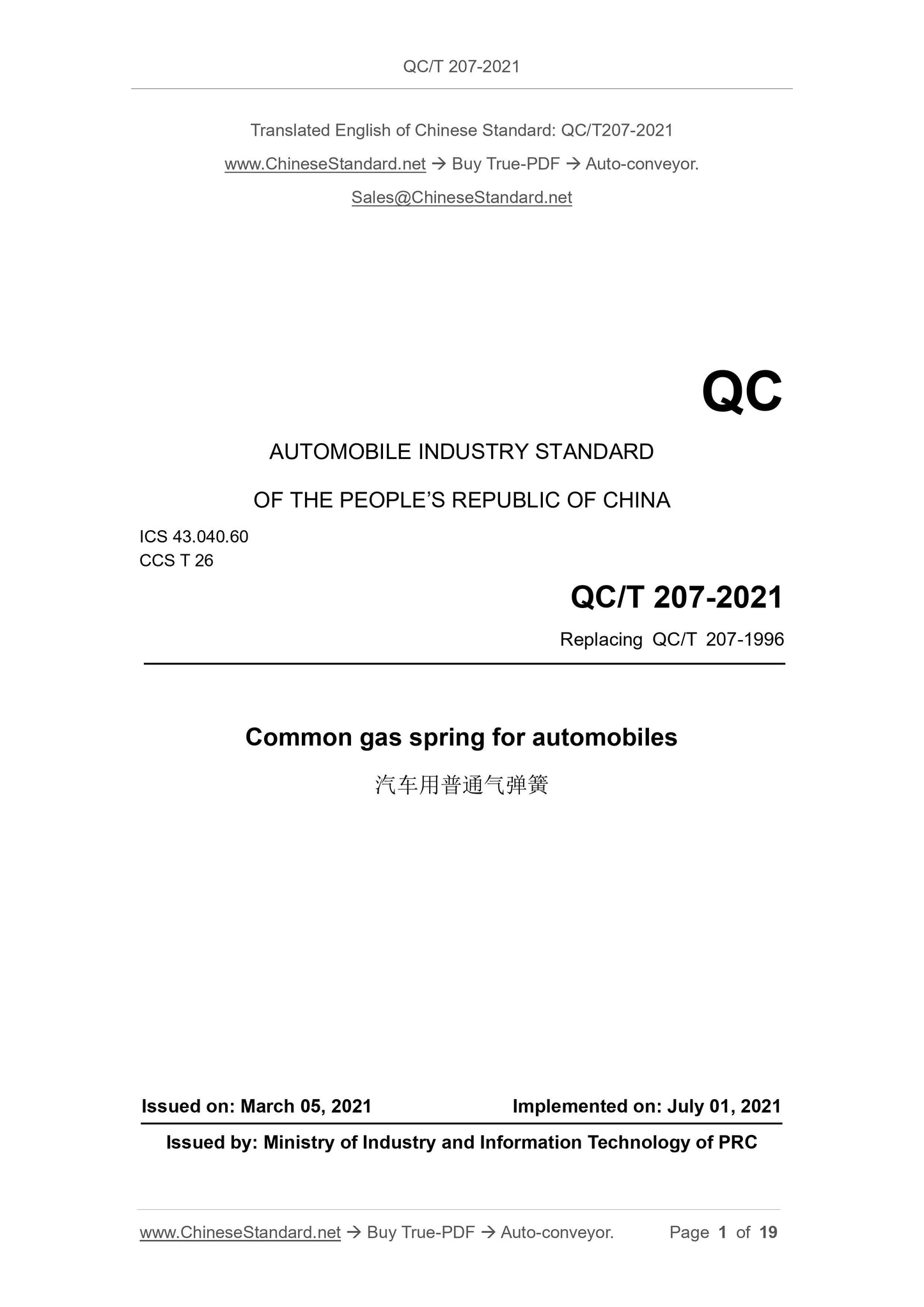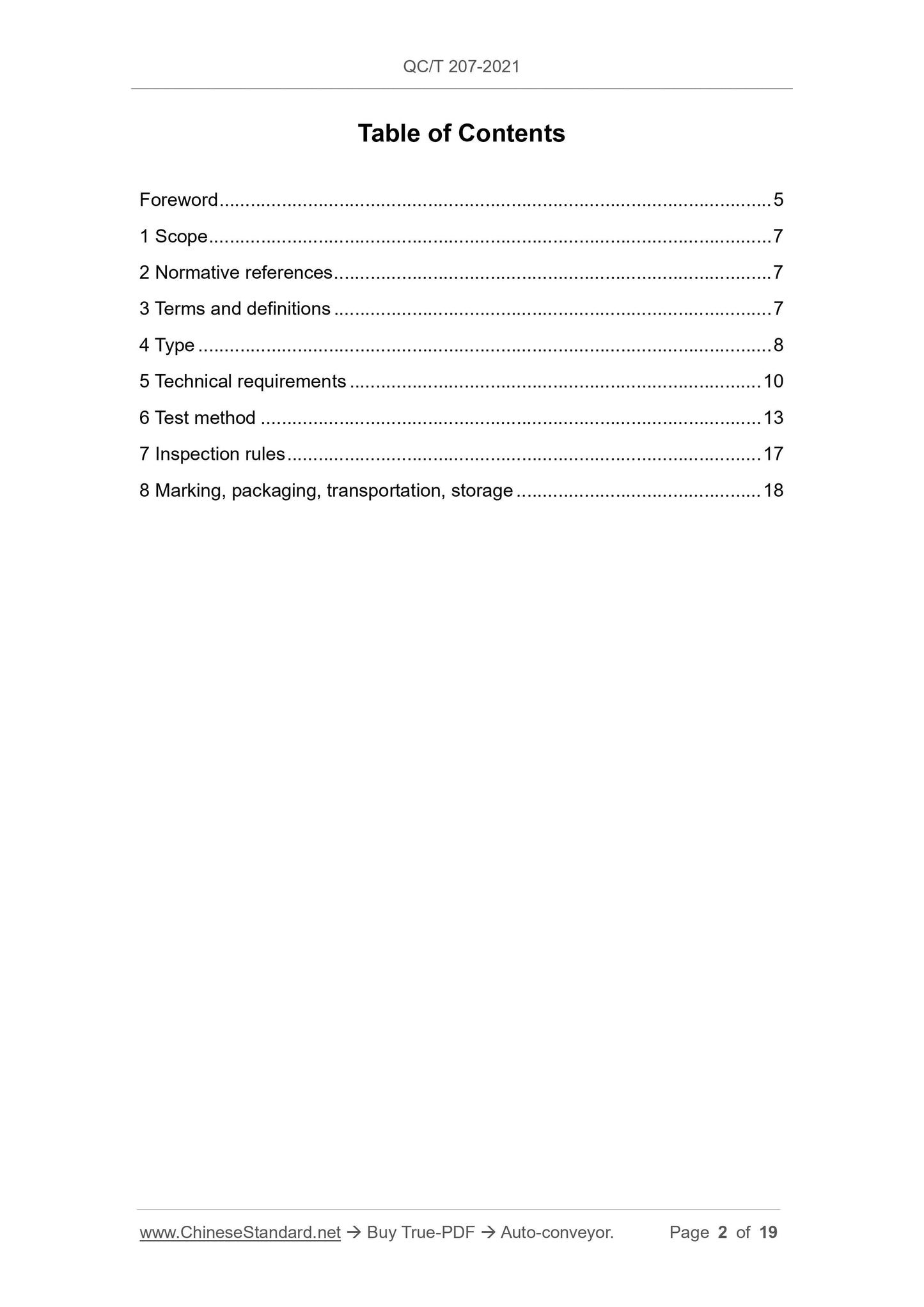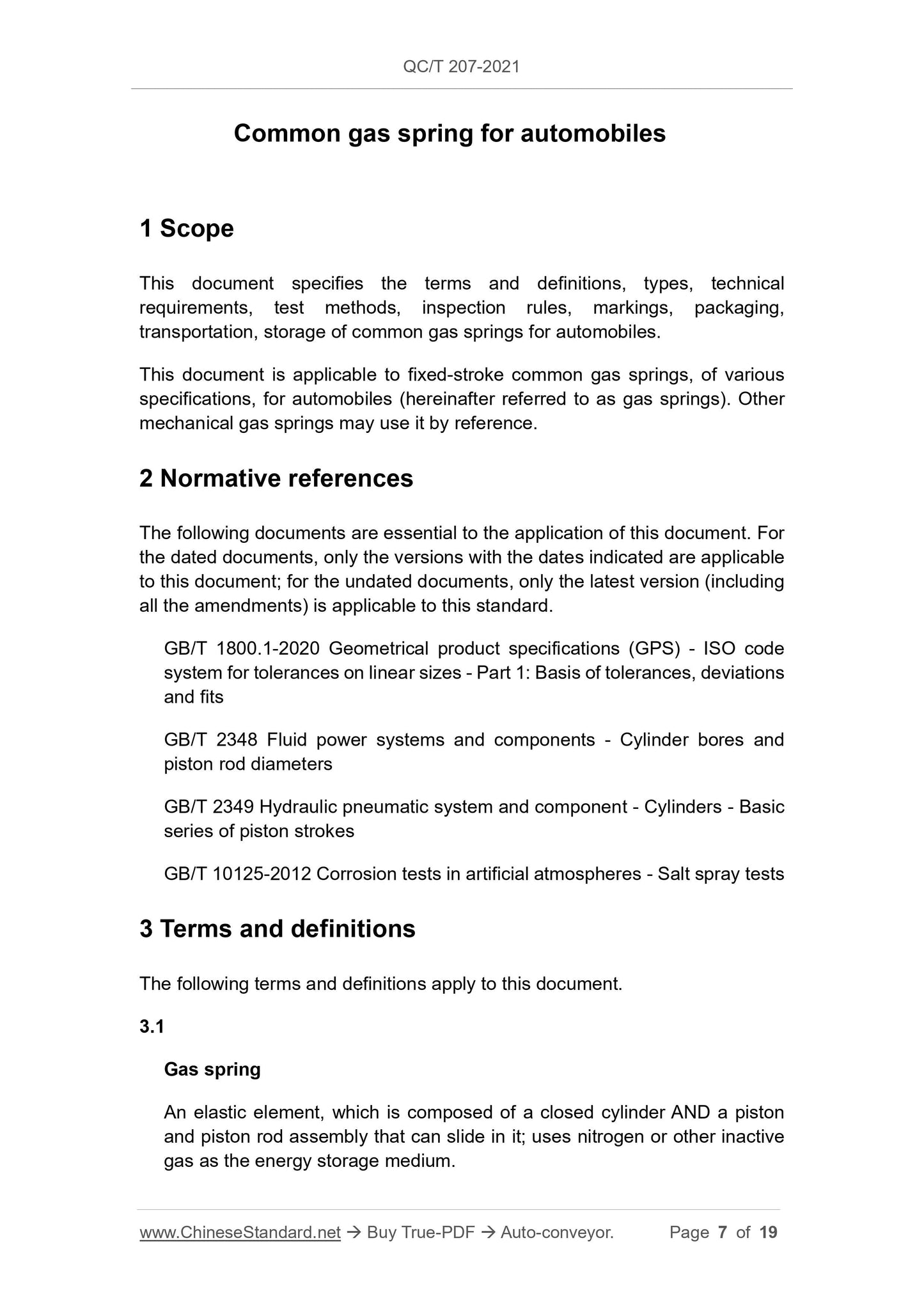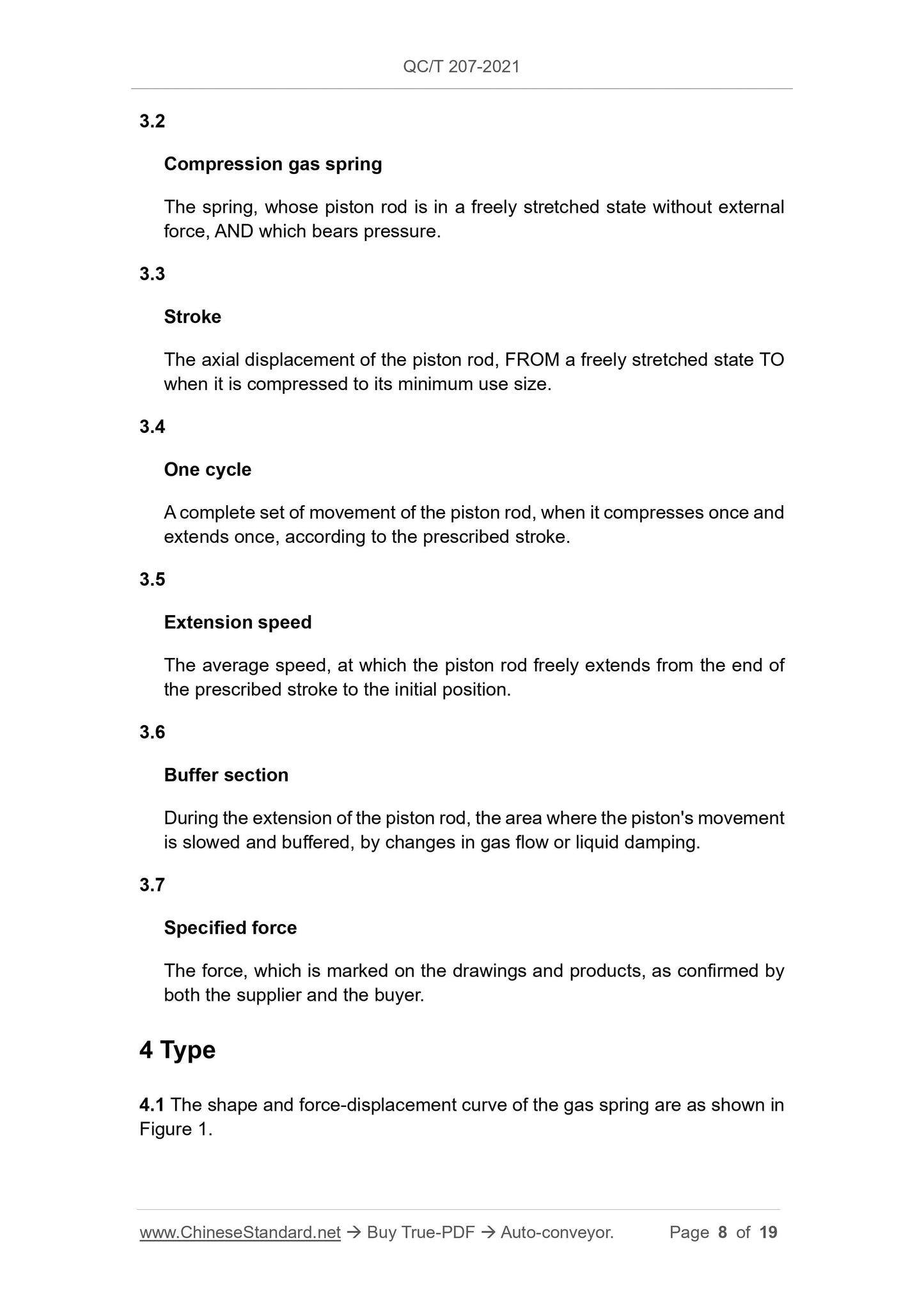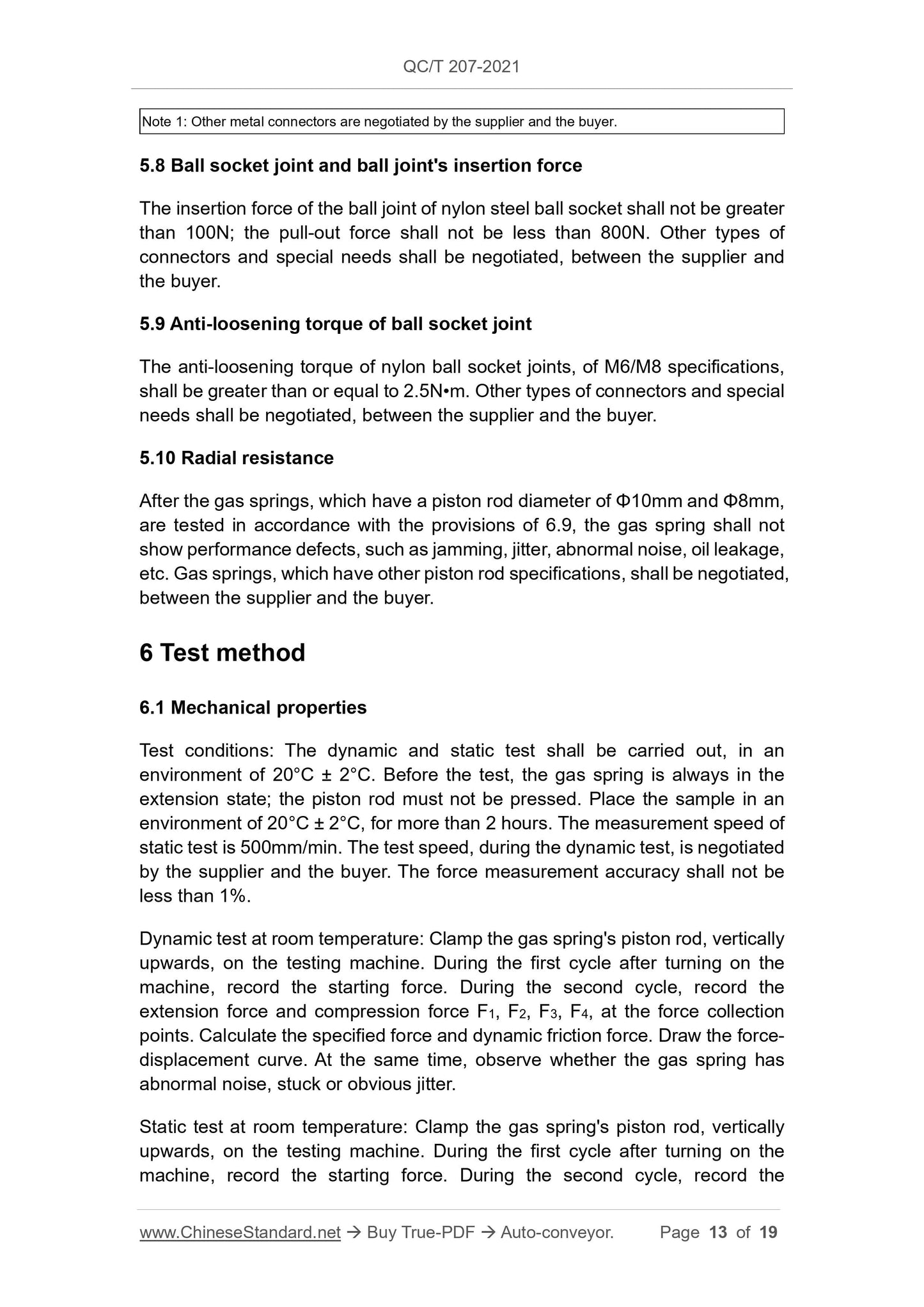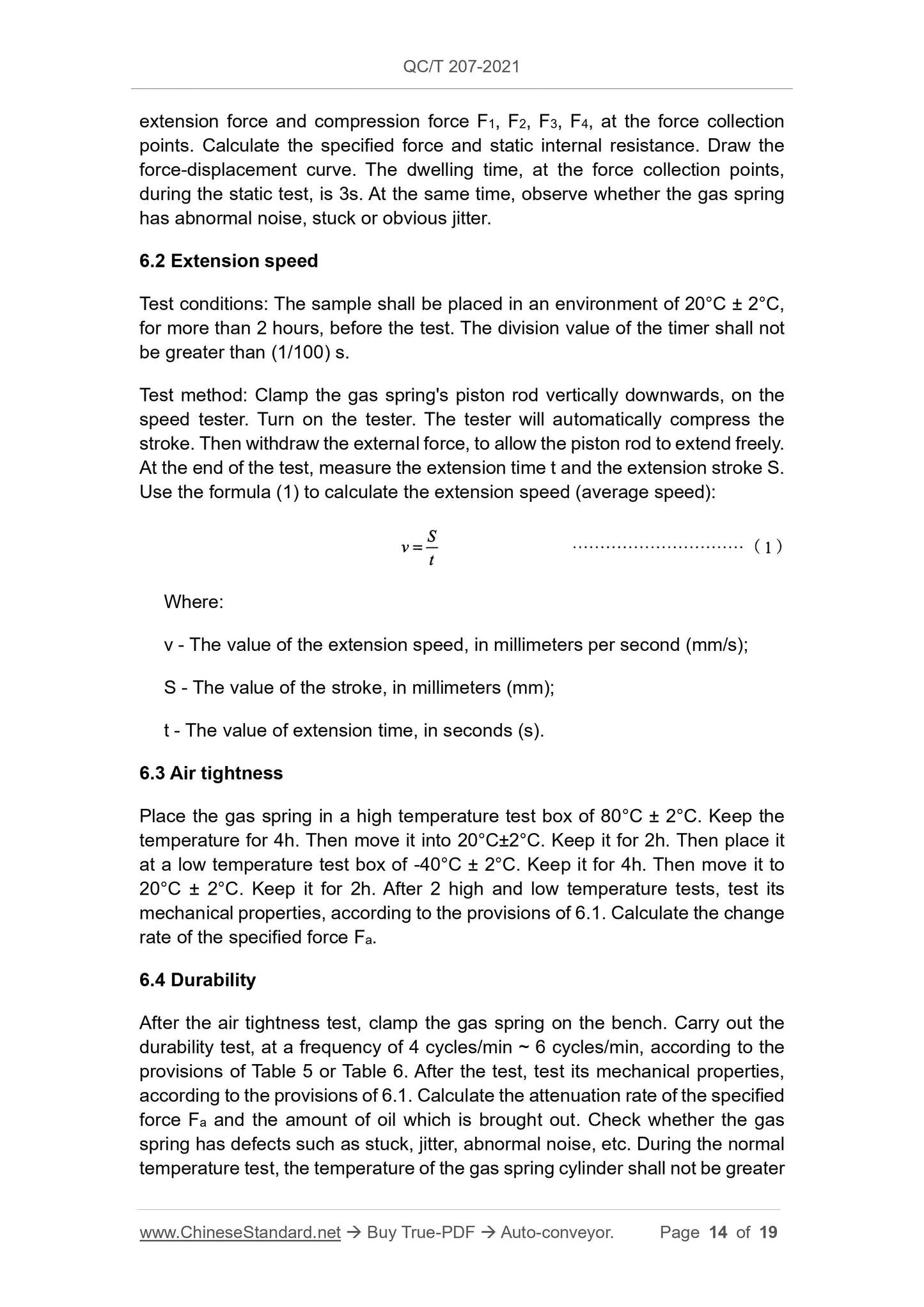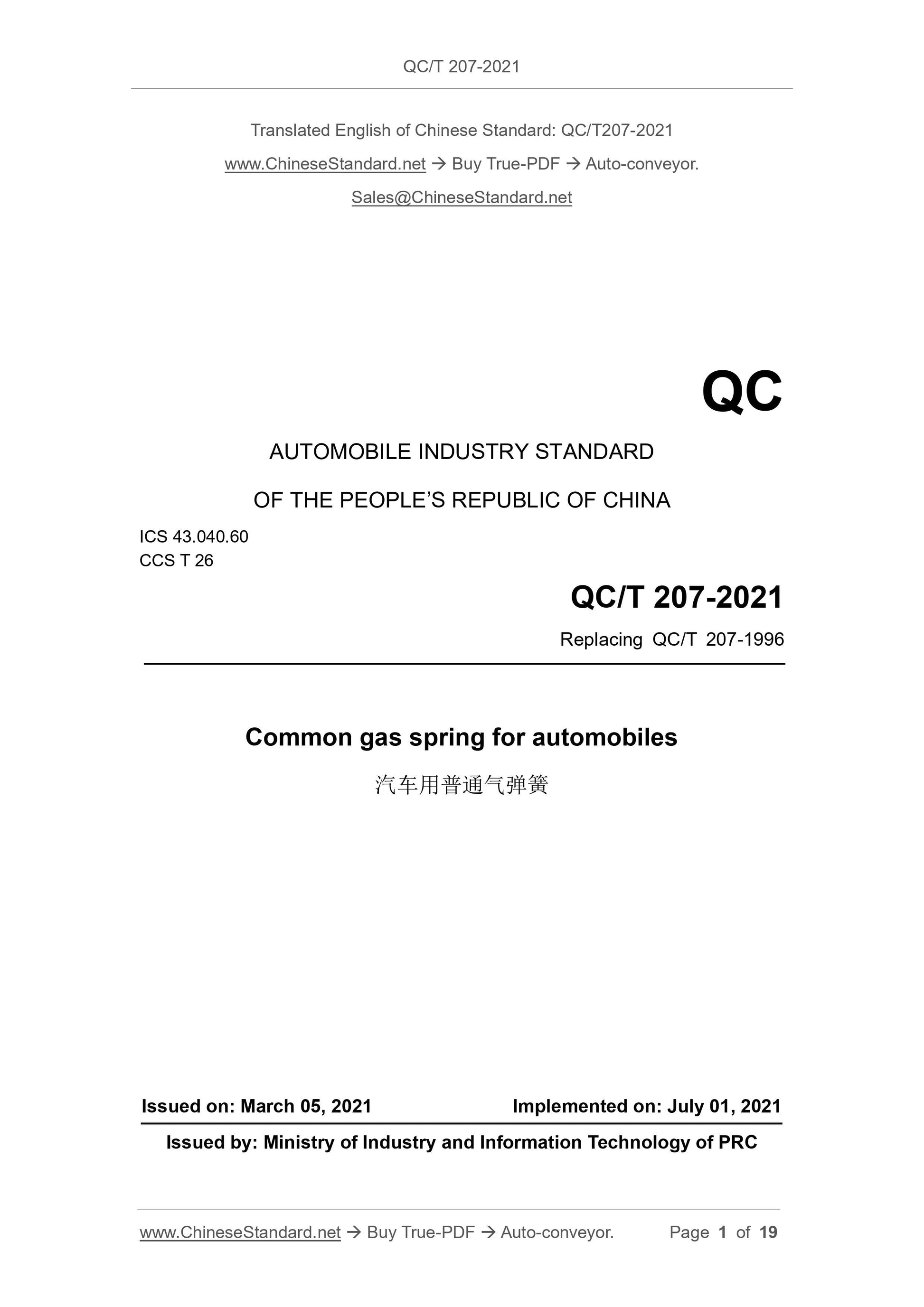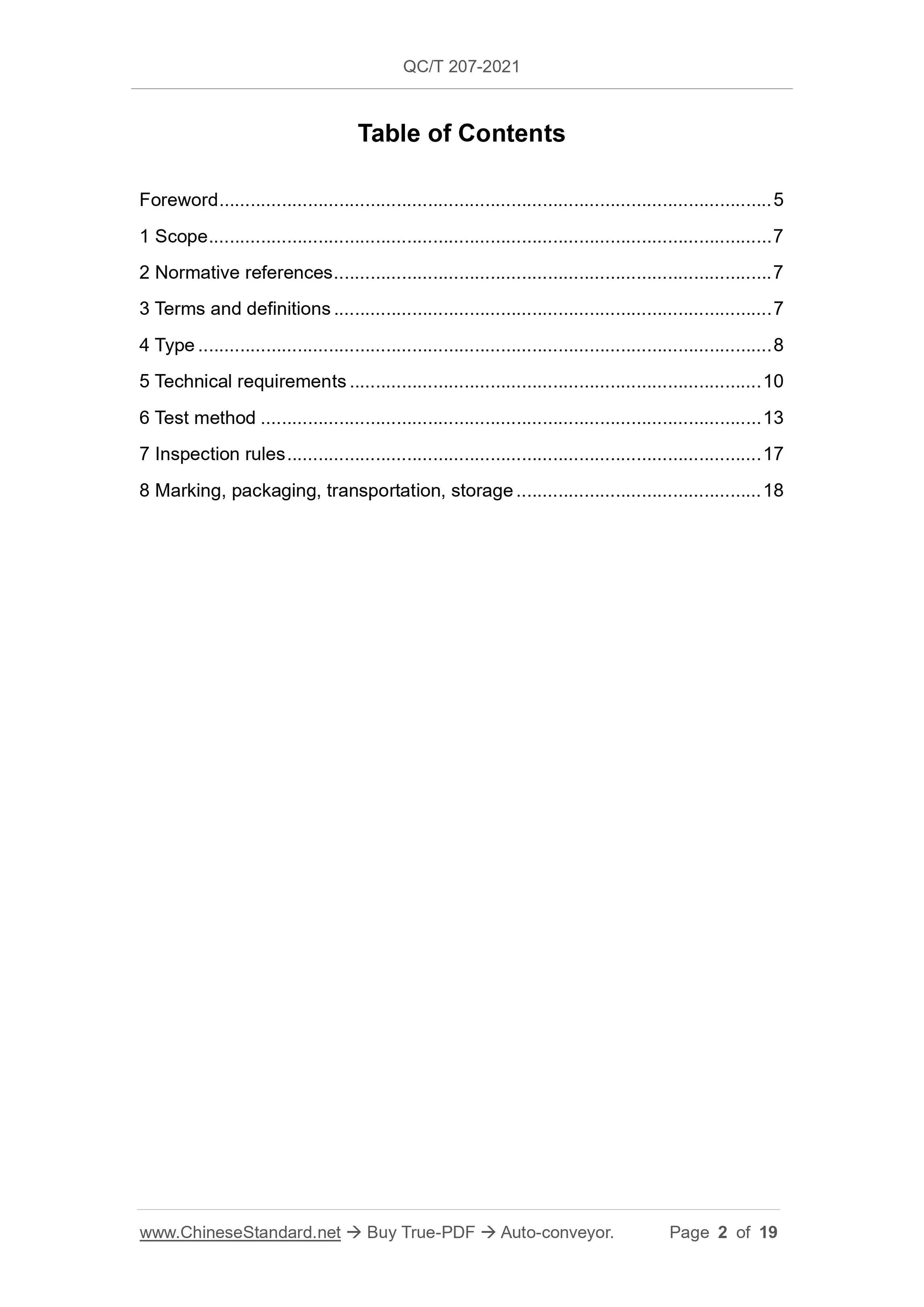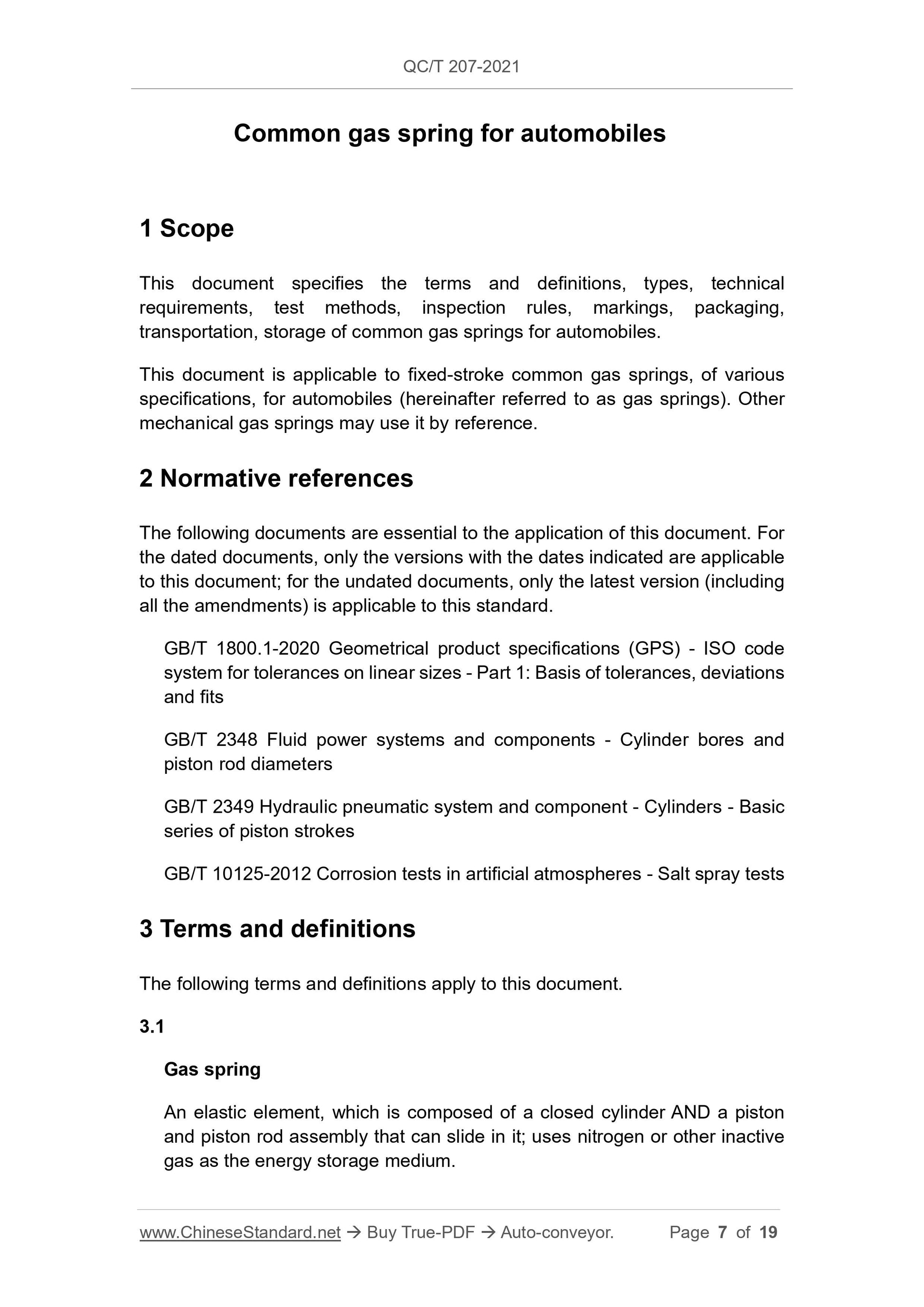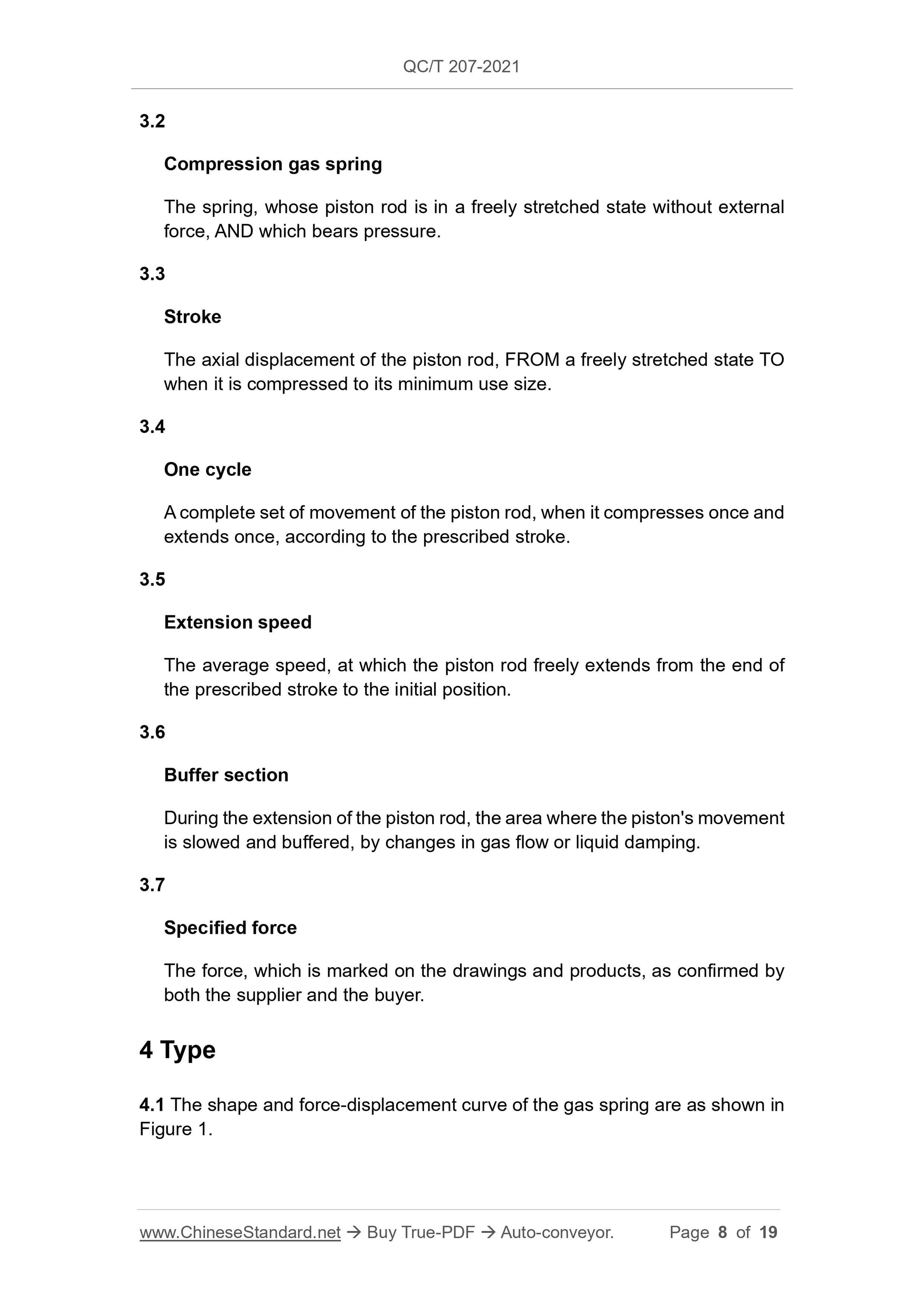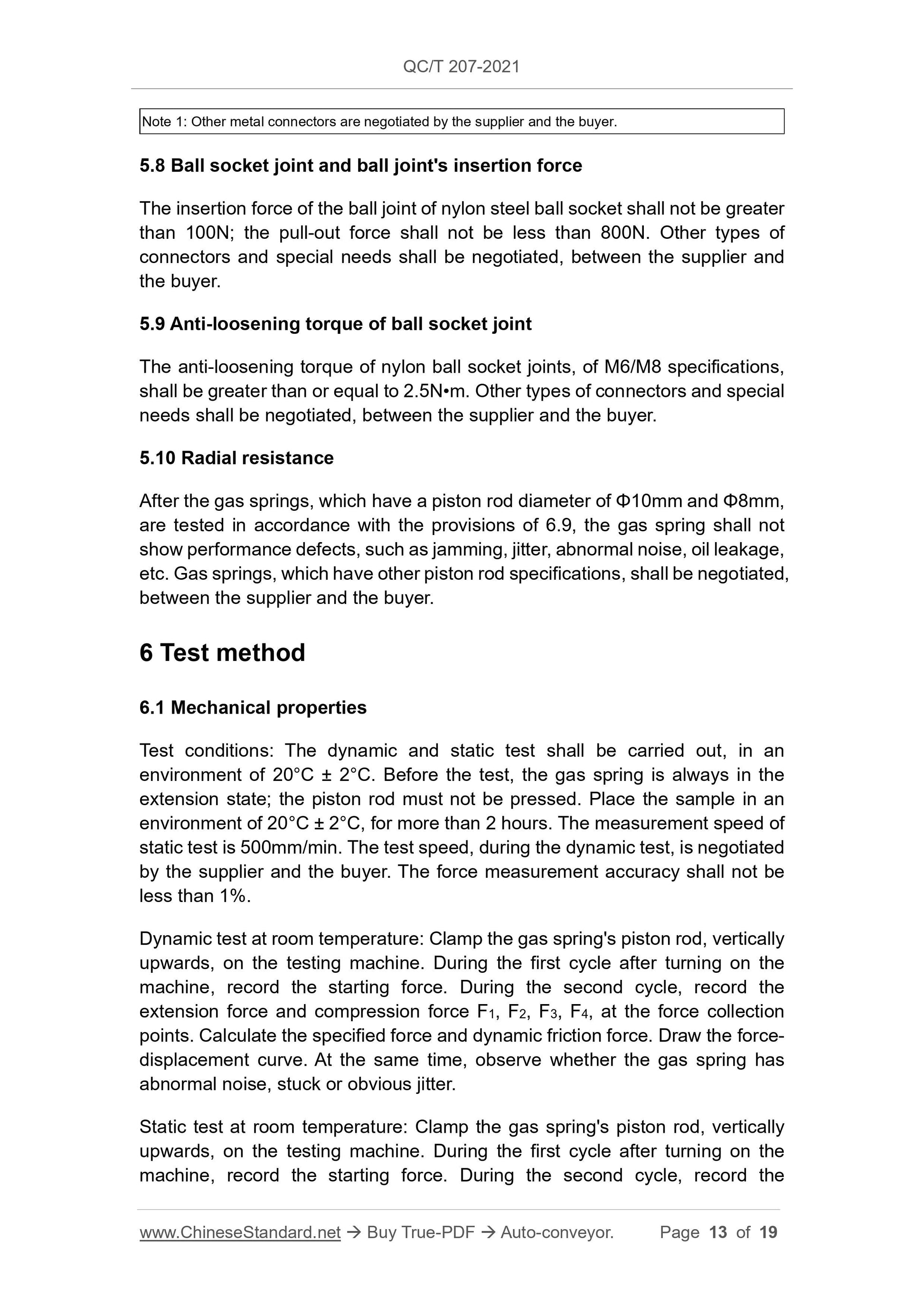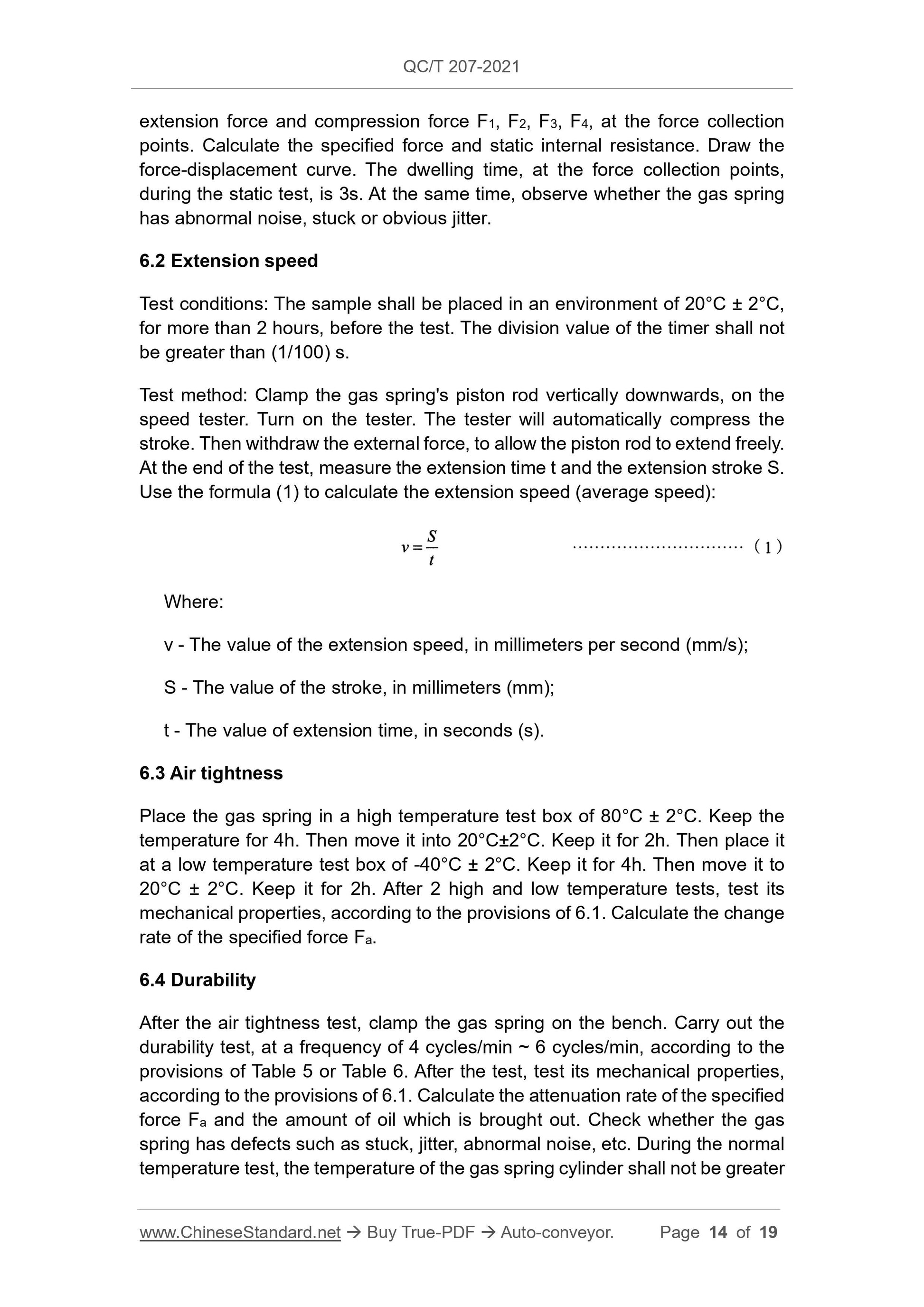1
/
of
6
www.ChineseStandard.us -- Field Test Asia Pte. Ltd.
QC/T 207-2021 English PDF (QC/T207-2021)
QC/T 207-2021 English PDF (QC/T207-2021)
Regular price
$230.00
Regular price
Sale price
$230.00
Unit price
/
per
Shipping calculated at checkout.
Couldn't load pickup availability
QC/T 207-2021: Common gas spring for automobiles
Delivery: 9 seconds. Download (& Email) true-PDF + Invoice.
Get Quotation: Click QC/T 207-2021 (Self-service in 1-minute)
Historical versions (Master-website): QC/T 207-2021
Preview True-PDF (Reload/Scroll-down if blank)
QC/T 207-2021
QC
AUTOMOBILE INDUSTRY STANDARD
OF THE PEOPLE’S REPUBLIC OF CHINA
ICS 43.040.60
CCS T 26
Replacing QC/T 207-1996
Common gas spring for automobiles
ISSUED ON: MARCH 05, 2021
IMPLEMENTED ON: JULY 01, 2021
Issued by: Ministry of Industry and Information Technology of PRC
Table of Contents
Foreword ... 5
1 Scope ... 7
2 Normative references ... 7
3 Terms and definitions ... 7
4 Type ... 8
5 Technical requirements ... 10
6 Test method ... 13
7 Inspection rules ... 17
8 Marking, packaging, transportation, storage ... 18
Common gas spring for automobiles
1 Scope
This document specifies the terms and definitions, types, technical
requirements, test methods, inspection rules, markings, packaging,
transportation, storage of common gas springs for automobiles.
This document is applicable to fixed-stroke common gas springs, of various
specifications, for automobiles (hereinafter referred to as gas springs). Other
mechanical gas springs may use it by reference.
2 Normative references
The following documents are essential to the application of this document. For
the dated documents, only the versions with the dates indicated are applicable
to this document; for the undated documents, only the latest version (including
all the amendments) is applicable to this standard.
GB/T 1800.1-2020 Geometrical product specifications (GPS) - ISO code
system for tolerances on linear sizes - Part 1: Basis of tolerances, deviations
and fits
GB/T 2348 Fluid power systems and components - Cylinder bores and
piston rod diameters
GB/T 2349 Hydraulic pneumatic system and component - Cylinders - Basic
series of piston strokes
GB/T 10125-2012 Corrosion tests in artificial atmospheres - Salt spray tests
3 Terms and definitions
The following terms and definitions apply to this document.
3.1
Gas spring
An elastic element, which is composed of a closed cylinder AND a piston
and piston rod assembly that can slide in it; uses nitrogen or other inactive
gas as the energy storage medium.
3.2
Compression gas spring
The spring, whose piston rod is in a freely stretched state without external
force, AND which bears pressure.
3.3
Stroke
The axial displacement of the piston rod, FROM a freely stretched state TO
when it is compressed to its minimum use size.
3.4
One cycle
A complete set of movement of the piston rod, when it compresses once and
extends once, according to the prescribed stroke.
3.5
Extension speed
The average speed, at which the piston rod freely extends from the end of
the prescribed stroke to the initial position.
3.6
Buffer section
During the extension of the piston rod, the area where the piston's movement
is slowed and buffered, by changes in gas flow or liquid damping.
3.7
Specified force
The force, which is marked on the drawings and products, as confirmed by
both the supplier and the buyer.
4 Type
4.1 The shape and force-displacement curve of the gas spring are as shown in
Figure 1.
Note 1: Other metal connectors are negotiated by the supplier and the buyer.
5.8 Ball socket joint and ball joint's insertion force
The insertion force of the ball joint of nylon steel ball socket shall not be greater
than 100N; the pull-out force shall not be less than 800N. Other types of
connectors and special needs shall be negotiated, between the supplier and
the buyer.
5.9 Anti-loosening torque of ball socket joint
The anti-loosening torque of nylon ball socket joints, of M6/M8 specifications,
shall be greater than or equal to 2.5N•m. Other types of connectors and special
needs shall be negotiated, between the supplier and the buyer.
5.10 Radial resistance
After the gas springs, which have a piston rod diameter of Φ10mm and Φ8mm,
are tested in accordance with the provisions of 6.9, the gas spring shall not
show performance defects, such as jamming, jitter, abnormal noise, oil leakage,
etc. Gas springs, which have other piston rod specifications, shall be negotiated,
between the supplier and the buyer.
6 Test method
6.1 Mechanical properties
Test conditions: The dynamic and static test shall be carried out, in an
environment of 20°C ± 2°C. Before the test, the gas spring is always in the
extension state; the piston rod must not be pressed. Place the sample in an
environment of 20°C ± 2°C, for more than 2 hours. The measurement speed of
static test is 500mm/min. The test speed, during the dynamic test, is negotiated
by the supplier and the buyer. The force measurement accuracy shall not be
less than 1%.
Dynamic test at room temperature: Clamp the gas spring's piston rod, vertically
upwards, on the testing machine. During the first cycle after turning on the
machine, record the starting force. During the second cycle, record the
extension force and compression force F1, F2, F3, F4, at the force collection
points. Calculate the specified force and dynamic friction force. Draw the force-
displacement curve. At the same time, observe whether the gas spring has
abnormal noise, stuck or obvious jitter.
Static test at room temperature: Clamp the gas spring's piston rod, vertically
upwards, on the testing machine. During the first cycle after turning on the
machine, record the starting force. During the second cycle, record the
extension force and compression force F1, F2, F3, F4, at the force collection
points. Calculate the specified force and static internal resistance. Draw the
force-displacement curve. The dwelling time, at the force collection points,
during the static test, is 3s. At the same time, observe whether the gas spring
has abnormal noise, stuck or obvious jitter.
6.2 Extension speed
Test conditions: The sample shall be placed in an environment of 20°C ± 2°C,
for more than 2 hours, before the test. The division value of the timer shall not
be greater than (1/100) s.
Test method: Clamp the gas spring's piston rod vertically downwards, on the
speed tester. Turn on the tester. The tester will automatically compress the
stroke. Then withdraw the external force, to allow the piston rod to extend freely.
At the end of the test, measure the extension time t and the extension stroke S.
Use the formula (1) to calculate the extension speed (average speed):
Where:
v - The value of the extension speed, in millimeters per second (mm/s);
S - The value of the stroke, in millimeters (mm);
t - The value of extension time, in seconds (s).
6.3 Air tightness
Place the gas spring in a high temperature test box of 80°C ± 2°C. Keep the
temperature for 4h. Then move it into 20°C±2°C. Keep it for 2h. Then place it
at a low temperature test box of -40°C ± 2°C. Keep it for 4h. Then move it to
20°C ± 2°C. Keep it for 2h. After 2 high and low temperature tests, test its
mechanical properties, according to the provisions of 6.1. Calculate the change
rate of the specified force Fa.
6.4 Durability
After the air tightness test, clamp the gas spring on the bench. Carry out the
durability test, at a frequency of 4 cycles/min ~ 6 cycles/min, according to the
provisions of Table 5 or Table 6. After the test, test its mechanical properties,
according to the provisions of 6.1. Calculate the attenuation rate of the specified
force Fa and the amount of oil which is brought out. Check whether the gas
spring has defects such as stuck, jitter, abnormal noise, etc. During the normal
temperature test, the temperature of the gas spring cylinder shall not be greater
QC/T 207-2021
QC
AUTOMOBILE INDUSTRY STANDARD
OF THE PEOPLE’S REPUBLIC OF CHINA
ICS 43.040.60
CCS T 26
Replacing QC/T 207-1996
Common gas spring for automobiles
ISSUED ON: MARCH 05, 2021
IMPLEMENTED ON: JULY 01, 2021
Issued by: Ministry of Industry and Information Technology of PRC
Table of Contents
Foreword ... 5
1 Scope ... 7
2 Normative references ... 7
3 Terms and definitions ... 7
4 Type ... 8
5 Technical requirements ... 10
6 Test method ... 13
7 Inspection rules ... 17
8 Marking, packaging, transportation, storage ... 18
Common gas spring for automobiles
1 Scope
This document specifies the terms and definitions, types, technical
requirements, test methods, inspection rules, markings, packaging,
transportation, storage of common gas springs for automobiles.
This document is applicable to fixed-stroke common gas springs, of various
specifications, for automobiles (hereinafter referred to as gas springs). Other
mechanical gas springs may use it by reference.
2 Normative references
The following documents are essential to the application of this document. For
the dated documents, only the versions with the dates indicated are applicable
to this document; for the undated documents, only the latest version (including
all the amendments) is applicable to this standard.
GB/T 1800.1-2020 Geometrical product specifications (GPS) - ISO code
system for tolerances on linear sizes - Part 1: Basis of tolerances, deviations
and fits
GB/T 2348 Fluid power systems and components - Cylinder bores and
piston rod diameters
GB/T 2349 Hydraulic pneumatic system and component - Cylinders - Basic
series of piston strokes
GB/T 10125-2012 Corrosion tests in artificial atmospheres - Salt spray tests
3 Terms and definitions
The following terms and definitions apply to this document.
3.1
Gas spring
An elastic element, which is composed of a closed cylinder AND a piston
and piston rod assembly that can slide in it; uses nitrogen or other inactive
gas as the energy storage medium.
3.2
Compression gas spring
The spring, whose piston rod is in a freely stretched state without external
force, AND which bears pressure.
3.3
Stroke
The axial displacement of the piston rod, FROM a freely stretched state TO
when it is compressed to its minimum use size.
3.4
One cycle
A complete set of movement of the piston rod, when it compresses once and
extends once, according to the prescribed stroke.
3.5
Extension speed
The average speed, at which the piston rod freely extends from the end of
the prescribed stroke to the initial position.
3.6
Buffer section
During the extension of the piston rod, the area where the piston's movement
is slowed and buffered, by changes in gas flow or liquid damping.
3.7
Specified force
The force, which is marked on the drawings and products, as confirmed by
both the supplier and the buyer.
4 Type
4.1 The shape and force-displacement curve of the gas spring are as shown in
Figure 1.
Note 1: Other metal connectors are negotiated by the supplier and the buyer.
5.8 Ball socket joint and ball joint's insertion force
The insertion force of the ball joint of nylon steel ball socket shall not be greater
than 100N; the pull-out force shall not be less than 800N. Other types of
connectors and special needs shall be negotiated, between the supplier and
the buyer.
5.9 Anti-loosening torque of ball socket joint
The anti-loosening torque of nylon ball socket joints, of M6/M8 specifications,
shall be greater than or equal to 2.5N•m. Other types of connectors and special
needs shall be negotiated, between the supplier and the buyer.
5.10 Radial resistance
After the gas springs, which have a piston rod diameter of Φ10mm and Φ8mm,
are tested in accordance with the provisions of 6.9, the gas spring shall not
show performance defects, such as jamming, jitter, abnormal noise, oil leakage,
etc. Gas springs, which have other piston rod specifications, shall be negotiated,
between the supplier and the buyer.
6 Test method
6.1 Mechanical properties
Test conditions: The dynamic and static test shall be carried out, in an
environment of 20°C ± 2°C. Before the test, the gas spring is always in the
extension state; the piston rod must not be pressed. Place the sample in an
environment of 20°C ± 2°C, for more than 2 hours. The measurement speed of
static test is 500mm/min. The test speed, during the dynamic test, is negotiated
by the supplier and the buyer. The force measurement accuracy shall not be
less than 1%.
Dynamic test at room temperature: Clamp the gas spring's piston rod, vertically
upwards, on the testing machine. During the first cycle after turning on the
machine, record the starting force. During the second cycle, record the
extension force and compression force F1, F2, F3, F4, at the force collection
points. Calculate the specified force and dynamic friction force. Draw the force-
displacement curve. At the same time, observe whether the gas spring has
abnormal noise, stuck or obvious jitter.
Static test at room temperature: Clamp the gas spring's piston rod, vertically
upwards, on the testing machine. During the first cycle after turning on the
machine, record the starting force. During the second cycle, record the
extension force and compression force F1, F2, F3, F4, at the force collection
points. Calculate the specified force and static internal resistance. Draw the
force-displacement curve. The dwelling time, at the force collection points,
during the static test, is 3s. At the same time, observe whether the gas spring
has abnormal noise, stuck or obvious jitter.
6.2 Extension speed
Test conditions: The sample shall be placed in an environment of 20°C ± 2°C,
for more than 2 hours, before the test. The division value of the timer shall not
be greater than (1/100) s.
Test method: Clamp the gas spring's piston rod vertically downwards, on the
speed tester. Turn on the tester. The tester will automatically compress the
stroke. Then withdraw the external force, to allow the piston rod to extend freely.
At the end of the test, measure the extension time t and the extension stroke S.
Use the formula (1) to calculate the extension speed (average speed):
Where:
v - The value of the extension speed, in millimeters per second (mm/s);
S - The value of the stroke, in millimeters (mm);
t - The value of extension time, in s...
Delivery: 9 seconds. Download (& Email) true-PDF + Invoice.
Get Quotation: Click QC/T 207-2021 (Self-service in 1-minute)
Historical versions (Master-website): QC/T 207-2021
Preview True-PDF (Reload/Scroll-down if blank)
QC/T 207-2021
QC
AUTOMOBILE INDUSTRY STANDARD
OF THE PEOPLE’S REPUBLIC OF CHINA
ICS 43.040.60
CCS T 26
Replacing QC/T 207-1996
Common gas spring for automobiles
ISSUED ON: MARCH 05, 2021
IMPLEMENTED ON: JULY 01, 2021
Issued by: Ministry of Industry and Information Technology of PRC
Table of Contents
Foreword ... 5
1 Scope ... 7
2 Normative references ... 7
3 Terms and definitions ... 7
4 Type ... 8
5 Technical requirements ... 10
6 Test method ... 13
7 Inspection rules ... 17
8 Marking, packaging, transportation, storage ... 18
Common gas spring for automobiles
1 Scope
This document specifies the terms and definitions, types, technical
requirements, test methods, inspection rules, markings, packaging,
transportation, storage of common gas springs for automobiles.
This document is applicable to fixed-stroke common gas springs, of various
specifications, for automobiles (hereinafter referred to as gas springs). Other
mechanical gas springs may use it by reference.
2 Normative references
The following documents are essential to the application of this document. For
the dated documents, only the versions with the dates indicated are applicable
to this document; for the undated documents, only the latest version (including
all the amendments) is applicable to this standard.
GB/T 1800.1-2020 Geometrical product specifications (GPS) - ISO code
system for tolerances on linear sizes - Part 1: Basis of tolerances, deviations
and fits
GB/T 2348 Fluid power systems and components - Cylinder bores and
piston rod diameters
GB/T 2349 Hydraulic pneumatic system and component - Cylinders - Basic
series of piston strokes
GB/T 10125-2012 Corrosion tests in artificial atmospheres - Salt spray tests
3 Terms and definitions
The following terms and definitions apply to this document.
3.1
Gas spring
An elastic element, which is composed of a closed cylinder AND a piston
and piston rod assembly that can slide in it; uses nitrogen or other inactive
gas as the energy storage medium.
3.2
Compression gas spring
The spring, whose piston rod is in a freely stretched state without external
force, AND which bears pressure.
3.3
Stroke
The axial displacement of the piston rod, FROM a freely stretched state TO
when it is compressed to its minimum use size.
3.4
One cycle
A complete set of movement of the piston rod, when it compresses once and
extends once, according to the prescribed stroke.
3.5
Extension speed
The average speed, at which the piston rod freely extends from the end of
the prescribed stroke to the initial position.
3.6
Buffer section
During the extension of the piston rod, the area where the piston's movement
is slowed and buffered, by changes in gas flow or liquid damping.
3.7
Specified force
The force, which is marked on the drawings and products, as confirmed by
both the supplier and the buyer.
4 Type
4.1 The shape and force-displacement curve of the gas spring are as shown in
Figure 1.
Note 1: Other metal connectors are negotiated by the supplier and the buyer.
5.8 Ball socket joint and ball joint's insertion force
The insertion force of the ball joint of nylon steel ball socket shall not be greater
than 100N; the pull-out force shall not be less than 800N. Other types of
connectors and special needs shall be negotiated, between the supplier and
the buyer.
5.9 Anti-loosening torque of ball socket joint
The anti-loosening torque of nylon ball socket joints, of M6/M8 specifications,
shall be greater than or equal to 2.5N•m. Other types of connectors and special
needs shall be negotiated, between the supplier and the buyer.
5.10 Radial resistance
After the gas springs, which have a piston rod diameter of Φ10mm and Φ8mm,
are tested in accordance with the provisions of 6.9, the gas spring shall not
show performance defects, such as jamming, jitter, abnormal noise, oil leakage,
etc. Gas springs, which have other piston rod specifications, shall be negotiated,
between the supplier and the buyer.
6 Test method
6.1 Mechanical properties
Test conditions: The dynamic and static test shall be carried out, in an
environment of 20°C ± 2°C. Before the test, the gas spring is always in the
extension state; the piston rod must not be pressed. Place the sample in an
environment of 20°C ± 2°C, for more than 2 hours. The measurement speed of
static test is 500mm/min. The test speed, during the dynamic test, is negotiated
by the supplier and the buyer. The force measurement accuracy shall not be
less than 1%.
Dynamic test at room temperature: Clamp the gas spring's piston rod, vertically
upwards, on the testing machine. During the first cycle after turning on the
machine, record the starting force. During the second cycle, record the
extension force and compression force F1, F2, F3, F4, at the force collection
points. Calculate the specified force and dynamic friction force. Draw the force-
displacement curve. At the same time, observe whether the gas spring has
abnormal noise, stuck or obvious jitter.
Static test at room temperature: Clamp the gas spring's piston rod, vertically
upwards, on the testing machine. During the first cycle after turning on the
machine, record the starting force. During the second cycle, record the
extension force and compression force F1, F2, F3, F4, at the force collection
points. Calculate the specified force and static internal resistance. Draw the
force-displacement curve. The dwelling time, at the force collection points,
during the static test, is 3s. At the same time, observe whether the gas spring
has abnormal noise, stuck or obvious jitter.
6.2 Extension speed
Test conditions: The sample shall be placed in an environment of 20°C ± 2°C,
for more than 2 hours, before the test. The division value of the timer shall not
be greater than (1/100) s.
Test method: Clamp the gas spring's piston rod vertically downwards, on the
speed tester. Turn on the tester. The tester will automatically compress the
stroke. Then withdraw the external force, to allow the piston rod to extend freely.
At the end of the test, measure the extension time t and the extension stroke S.
Use the formula (1) to calculate the extension speed (average speed):
Where:
v - The value of the extension speed, in millimeters per second (mm/s);
S - The value of the stroke, in millimeters (mm);
t - The value of extension time, in seconds (s).
6.3 Air tightness
Place the gas spring in a high temperature test box of 80°C ± 2°C. Keep the
temperature for 4h. Then move it into 20°C±2°C. Keep it for 2h. Then place it
at a low temperature test box of -40°C ± 2°C. Keep it for 4h. Then move it to
20°C ± 2°C. Keep it for 2h. After 2 high and low temperature tests, test its
mechanical properties, according to the provisions of 6.1. Calculate the change
rate of the specified force Fa.
6.4 Durability
After the air tightness test, clamp the gas spring on the bench. Carry out the
durability test, at a frequency of 4 cycles/min ~ 6 cycles/min, according to the
provisions of Table 5 or Table 6. After the test, test its mechanical properties,
according to the provisions of 6.1. Calculate the attenuation rate of the specified
force Fa and the amount of oil which is brought out. Check whether the gas
spring has defects such as stuck, jitter, abnormal noise, etc. During the normal
temperature test, the temperature of the gas spring cylinder shall not be greater
QC/T 207-2021
QC
AUTOMOBILE INDUSTRY STANDARD
OF THE PEOPLE’S REPUBLIC OF CHINA
ICS 43.040.60
CCS T 26
Replacing QC/T 207-1996
Common gas spring for automobiles
ISSUED ON: MARCH 05, 2021
IMPLEMENTED ON: JULY 01, 2021
Issued by: Ministry of Industry and Information Technology of PRC
Table of Contents
Foreword ... 5
1 Scope ... 7
2 Normative references ... 7
3 Terms and definitions ... 7
4 Type ... 8
5 Technical requirements ... 10
6 Test method ... 13
7 Inspection rules ... 17
8 Marking, packaging, transportation, storage ... 18
Common gas spring for automobiles
1 Scope
This document specifies the terms and definitions, types, technical
requirements, test methods, inspection rules, markings, packaging,
transportation, storage of common gas springs for automobiles.
This document is applicable to fixed-stroke common gas springs, of various
specifications, for automobiles (hereinafter referred to as gas springs). Other
mechanical gas springs may use it by reference.
2 Normative references
The following documents are essential to the application of this document. For
the dated documents, only the versions with the dates indicated are applicable
to this document; for the undated documents, only the latest version (including
all the amendments) is applicable to this standard.
GB/T 1800.1-2020 Geometrical product specifications (GPS) - ISO code
system for tolerances on linear sizes - Part 1: Basis of tolerances, deviations
and fits
GB/T 2348 Fluid power systems and components - Cylinder bores and
piston rod diameters
GB/T 2349 Hydraulic pneumatic system and component - Cylinders - Basic
series of piston strokes
GB/T 10125-2012 Corrosion tests in artificial atmospheres - Salt spray tests
3 Terms and definitions
The following terms and definitions apply to this document.
3.1
Gas spring
An elastic element, which is composed of a closed cylinder AND a piston
and piston rod assembly that can slide in it; uses nitrogen or other inactive
gas as the energy storage medium.
3.2
Compression gas spring
The spring, whose piston rod is in a freely stretched state without external
force, AND which bears pressure.
3.3
Stroke
The axial displacement of the piston rod, FROM a freely stretched state TO
when it is compressed to its minimum use size.
3.4
One cycle
A complete set of movement of the piston rod, when it compresses once and
extends once, according to the prescribed stroke.
3.5
Extension speed
The average speed, at which the piston rod freely extends from the end of
the prescribed stroke to the initial position.
3.6
Buffer section
During the extension of the piston rod, the area where the piston's movement
is slowed and buffered, by changes in gas flow or liquid damping.
3.7
Specified force
The force, which is marked on the drawings and products, as confirmed by
both the supplier and the buyer.
4 Type
4.1 The shape and force-displacement curve of the gas spring are as shown in
Figure 1.
Note 1: Other metal connectors are negotiated by the supplier and the buyer.
5.8 Ball socket joint and ball joint's insertion force
The insertion force of the ball joint of nylon steel ball socket shall not be greater
than 100N; the pull-out force shall not be less than 800N. Other types of
connectors and special needs shall be negotiated, between the supplier and
the buyer.
5.9 Anti-loosening torque of ball socket joint
The anti-loosening torque of nylon ball socket joints, of M6/M8 specifications,
shall be greater than or equal to 2.5N•m. Other types of connectors and special
needs shall be negotiated, between the supplier and the buyer.
5.10 Radial resistance
After the gas springs, which have a piston rod diameter of Φ10mm and Φ8mm,
are tested in accordance with the provisions of 6.9, the gas spring shall not
show performance defects, such as jamming, jitter, abnormal noise, oil leakage,
etc. Gas springs, which have other piston rod specifications, shall be negotiated,
between the supplier and the buyer.
6 Test method
6.1 Mechanical properties
Test conditions: The dynamic and static test shall be carried out, in an
environment of 20°C ± 2°C. Before the test, the gas spring is always in the
extension state; the piston rod must not be pressed. Place the sample in an
environment of 20°C ± 2°C, for more than 2 hours. The measurement speed of
static test is 500mm/min. The test speed, during the dynamic test, is negotiated
by the supplier and the buyer. The force measurement accuracy shall not be
less than 1%.
Dynamic test at room temperature: Clamp the gas spring's piston rod, vertically
upwards, on the testing machine. During the first cycle after turning on the
machine, record the starting force. During the second cycle, record the
extension force and compression force F1, F2, F3, F4, at the force collection
points. Calculate the specified force and dynamic friction force. Draw the force-
displacement curve. At the same time, observe whether the gas spring has
abnormal noise, stuck or obvious jitter.
Static test at room temperature: Clamp the gas spring's piston rod, vertically
upwards, on the testing machine. During the first cycle after turning on the
machine, record the starting force. During the second cycle, record the
extension force and compression force F1, F2, F3, F4, at the force collection
points. Calculate the specified force and static internal resistance. Draw the
force-displacement curve. The dwelling time, at the force collection points,
during the static test, is 3s. At the same time, observe whether the gas spring
has abnormal noise, stuck or obvious jitter.
6.2 Extension speed
Test conditions: The sample shall be placed in an environment of 20°C ± 2°C,
for more than 2 hours, before the test. The division value of the timer shall not
be greater than (1/100) s.
Test method: Clamp the gas spring's piston rod vertically downwards, on the
speed tester. Turn on the tester. The tester will automatically compress the
stroke. Then withdraw the external force, to allow the piston rod to extend freely.
At the end of the test, measure the extension time t and the extension stroke S.
Use the formula (1) to calculate the extension speed (average speed):
Where:
v - The value of the extension speed, in millimeters per second (mm/s);
S - The value of the stroke, in millimeters (mm);
t - The value of extension time, in s...
Share
